Apart from other humans, animals are the next best thing for companionship. The fact that they come in different species with different personalities makes it an even better experience. Not all animals are great pets, but some are exciting to observe in their natural environment. Though pets are kept mainly for pleasure, both organisms benefit from the relationship. Cats are one of the species that can be kept as companions. These creatures do not pose much health risk and do not require much attention. They are low maintenance and are useful for hunting rodents. One of the beautiful breeds of cat is the Turkish Angora Cat which is characterized by its all-white coat and piercing eyes. There are other colors available, including black with a chocolate undercoat and smoky colored ones. The eye colors include blue, green, amber, and sometimes heterochromatic, which is two different eye colors. Their pretty white coating protects them against harsh weather and gives them a dainty and elegant look. The tail is another distinctive feature on the cat because of its plumed structure, often carried perpendicular to its body. Some of the cat’s features are caused by gene mutations and will be looked at into detail later in the article.
The breed is sometimes called the Ankara cat or just Angora because of its origin from the Ankara region of Turkey. Before going in for animal as a pet, you should have some necessary information on the nature of that animal. Going in fully armed gives you a better understanding of picking which one is best for you. This article about the Turkish Angora is about to help you make informed decisions before choosing this breed as a companion.
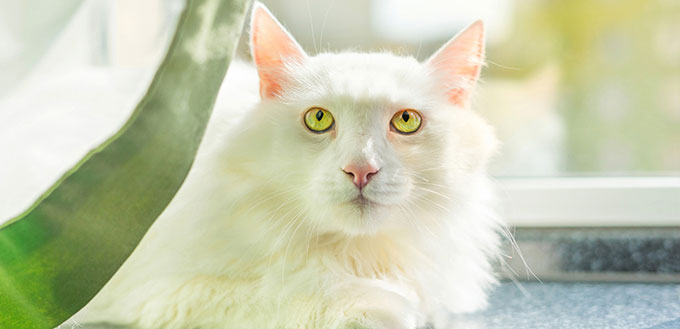
History of the Turkish Angora Cat
Like the name suggests this breed of cat is originally from Turkey and has been documented since the 17th Century. The Angora cats are the breed that developed through inbreeding and natural selection from the Anatolia region cats. As early as the 15th century, longhaired cats were imported into Europe from Asia and Persia. The continent recognized the breed as a distinct one in the 17th century and gave the breed names like ‘Persian cat’ and ‘Angora cat.’ Though the two are different, they are somewhat connected since the Persian cat was developed from the Angora cat. Several books were written during the 19th century on the differences between the two breeds and the disappearance of the Angora cat.
This breed was close to extinction because it was overused in the promotion of the Persian cat’s coat. Early in the 20th century the Ankara zoo took the initiative to preserve the breed and prevent its total disappearance. They began a breeding program that focused on protecting the white Angora cats. The program fancied the odd-eyed cats but chose only the white ones for breeding despite their deafness problem. The breed is still shown in the Ankara Zoo and is considered a national treasure in the country. The Turkish Angora was then sent to Canada in 1973 where it was accepted by the Cat Fanciers’ Association as a championship breed. It was not until 1978 that the all-white Turkish Angora cats were recognized. The kind has been growing ever since both in number and popularity.
Quick Facts About the Turkish Angora Cat
- They come in different colors
In the cat world, the Turkish Angora is the fairytale princess of them all. The first image that is portrayed about the cat is the plumed white cat in all of its glory. However, the breed comes in other colors to suit owners’ preference. There are about 20 different colors of this breed which include cinnamon, lavender, red, black, tabby, tabby-white and blue. The other colored cats have the same graceful look of the white cat, so you are not missing out by not getting one of those. In fact, the colored options are getting more attention these days as people are beginning to realize their equal loveliness to the white ones.
- They are brilliant
To be practical, cats are very intelligent in general. The creatures are smart, some with the ability to learn tricks and teach themselves to do things. With this attractive cat, it is no different: they are part of the breeds that show themselves how things work in their environment. You will notice that with no help from you, they have figured how to, for example, get the water running for baths. You might need to train it to stop the behaviors you do not agree with owing to their assertiveness. The advantage of this intelligence is that they will pick up new practices quickly so that you do not struggle when teaching them.
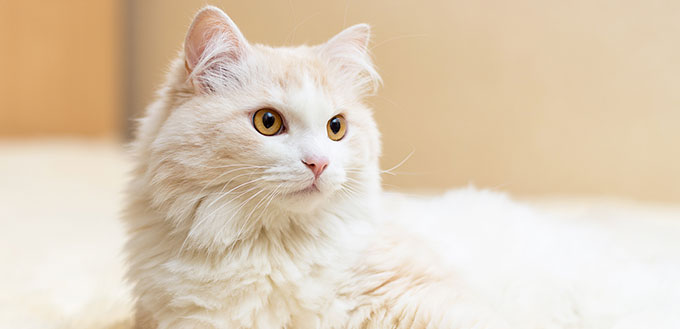
- They started the long-hair trends
The Turkish Angora cat is known as one of the oldest existing breeds of cats. This breed was developed through natural selection and are believed to carry the W gene responsible for long, white hair. It is therefore thought that most other long, white-haired cats are descendant of this breed. The gene actually carries a mutation which indicates an absence of color, hence the white appearance. Some say that the feature is an adaptation to the harsh climate of where they come from, which has been transferred from generation to generation. In the warmer weather, they shed their coat to become shorthairs, growing it back when it is cold.
- Mesmerizing eyes
One of the fascinating features on the Turkish Angora cat is brightly or odd-colored eyes. Some of them have both eyes in one color, while others have two different eye color. The most common eye color is blue, which is often accompanied by deafness. Other colors include amber and green, with these colors in the brightest form possible. The shape of the captivating eyes is almond, and this exotic look makes the cat a lovable breed for all cat lovers. The other features that set this breed apart from others include their pointed ears which are large and wide apart.
- They are not high maintenance
You might be thinking from the description of this beautiful animal that it might come with strict maintenance needs. Contrary to that concept, this breed of pet does not need much maintaining. Their coat is very silky and rarely tangles or mats. It is quite tricky for the strands to hold on to each other and so the layer stays smooth for the most part. If you have a white cat, then that is where you might need to do some bathing. Keep in mind, however, that cats are clean animals and so they would do most of the work for themselves.
You May Also Like: How to Bathe a Cat
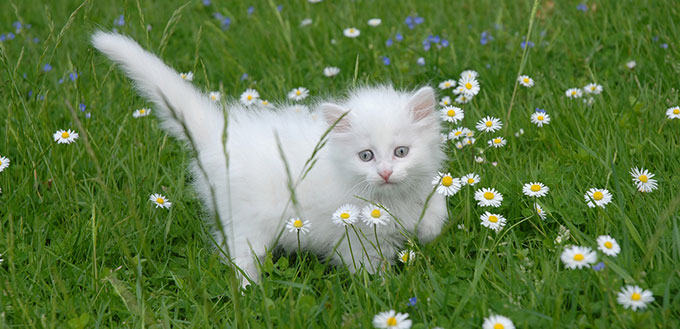
Things You Should Know About the Turkish Angora Cat
Health
The most common heath issue is deafness that is caused by the gene that gives the cat its blue eyes and white coat. Most of the cats with blue eyes are deaf in the ear closest to that eye. So in the case of the odd-eyed cat, if their left eye is blue, they are likely to be deaf in their left ear. This narrative does not apply to all Turkish Angora cats however: there are some blue-eyed cats that are not deaf. The deafness does not affect the life of the cats drastically: those kept indoors even tend to live healthy lives. Another illness that is present in this breed of cats is hypertrophic cardiomyopathy which occurs when the heart thickens. When this happens, its efficiency significantly reduces, and the symptoms appear in other parts of the body. It involves the heart using up more oxygen than needed and deprives other parts of the substance. The disease is more prone to and severe in male cats than their female counterparts. Also, it usually occurs between the ages of two and six. Not enough studies have gone into the illness, and at the moment, it is thought to be an autosomal dominant gene.
Ataxia is a hereditary illness that affects kittens of this breed. It is characterized by shaking in their body which makes them unsteady. The meaning is also in its name: ‘a’ for lacking and ‘taxia’ for order. They come in different forms, mainly based on which part of the nervous system is affected. Some affected areas are the head legs and torso, or all three in some cases. The veterinary is your best bet when it comes to medical issues, and you should make regular visits for a better understanding of what to do.
Feeding
When it comes to food, it is essential to make sure you are giving the right thing to your cat. Diets can make or break your cat’s health, and you should go the right way to save your cat from illnesses. The first thing to know is that their food should be balanced: that is, it should contain the food nutrients in their correct proportions. Now you would have to figure out what nutrient your cat needs. Cats are natural carnivores and so the components of their diet should come from animal sources. In this case, the protein will be the most critical part of the food. Protein comes in handy in the strengthening of bones and muscles, and since Turkish Angora cats have fragile bones, this might help. Fats are the next nutrient group that should be included in a cat’s diet. Fats contain certain amino acids that contribute to the well-being of the cat including their bones, hair, teeth, and nails.
Cats do not necessarily need fruits and vegetables like humans and can eat proteins and fat foods exclusively for the rest of their lives. Carbohydrates are a dangerous nutrient to feed your cat as they are linked to obesity. Turkish Angora cats, like most other cats, do not do well with being overweight. Due to their delicate bones, being too fat can affect their balance and eventually develop into diabetes. Carbohydrates must be avoided at all cost since the Turkish Angora’s system is not built for it. Always check the label of whatever cat food you purchase to make sure of the ingredients and consult the vet for more clarification.
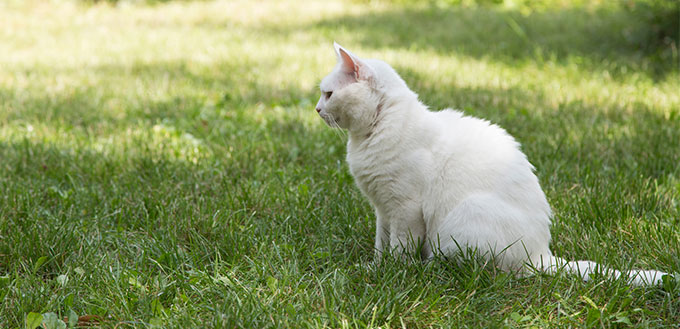
Care
Turkish Angora cats are not high maintenance but still need some amount of attention. Just like how you will take care of any other cat or pet there are some basic things you should not compromise on. Taking good care of the cat will provide you both with bonding time, and you will appreciate each other more. Angora cats require regular feeding with a balanced diet. They should be groomed weekly, paying attention to their teeth, hair, and nails. These cats have a mischievous streak, and so you might need to keep an extra eye on them. Do not be surprised if you find the cat on top of your fridge and do not be angry. Find a suitable trainer to teach your cat the right behaviors from bad ones. Make sure not to punish the cat excessively as it might become hostile towards you.
In terms of weight, be sure to check your cat’s weight regularly so that you know when to reduce the quantity of its diet or vice versa. Veterinarians are trained experts in the health of animals and just like how to take your car to the mechanic: you should visit them often.
Grooming
This process involves taking care of the cat’s physical features and appearance, including the fur, teeth, nails and even the ears. The purpose of grooming is to keep the cat clean to prevent future problems and illnesses. It will do you and your cat some good if it is kept looking good at all times. Some issues are preventable and do not need input from the vet, and grooming is the way to go. As already stated, this breed has a very silky coat which hardly tangles, and there is not much you can do in terms of grooming. However, brushing once a week will do some good to the cat since it produces dander. As mentioned earlier a white cat might need some bathing to keep the coat looking white and fresh. For the dander, use special cat shampoos that can resist and prevent it.
The Turkish Angora sometimes has teeth problems so you should brush them regularly, using cat toothpaste. Also, use a brush that is recommended for cats so that you do not hurt your pet. Clipping nails will help you a lot because the playful animal is most likely to be all over you and scratching is inevitable. If you cannot do it yourself, ask a professional to help. With grooming activities, it is advised to start at an early age so that as time goes on your pet gets used to it. After all, it is easier to teach a youngster than to change the habit of an adult.
Temperament
Turkish Angora cats are very playful animals which love to climb and play around. They love being above ground and they do that to observe what is going on below them. They are very athletic despite their delicate appearance, and their intelligence makes it even more fun for them. To prevent them from climbing your fridges or tables, you can build for them structures that they can rise and play around in. They can get very attached, and once they get to know you, you have a shadow for life. They always want to be around and show interest in every aspect of your life. The cats can get overprotective of their owner once they get used to them. They have a social personality and a great sense of humor. You can have them around friends and children and even other pets. However, you would need to have a ‘meet and greet’ with the other animals first since this breed likes to be the alpha in the group. If your home is filled with high activity all the time then this cat will make an excellent fit.
Unlike some other cats, this breed loves water and will be quick to jump in the pull or turn on the taps for a bath. Just like many others, they will not be pleased to be left alone and may develop depression. You cannot have this pet if you are not around often. If you want it badly enough, you must make sure there is someone to fill in your absence.
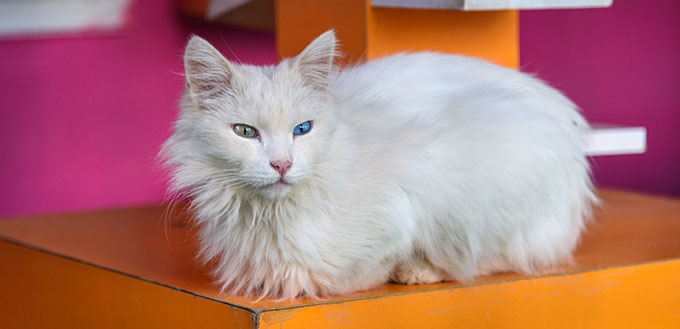
To Summarize
Cats are loveable creatures that do not need much maintenance because of their independent nature. Turkish Angora cats are gorgeous and might be the exception to the rule. They are indeed low maintenance but love attention. They will follow you everywhere with their long hair and bright eyes. To fully understand this breed, you should be aware of where they have come from and what they are made of.
The above information gives you insight to help you choose your animal companion. They are as tender as they look but still have the energy to keep you entertained. You can keep this breed with other pets and humans without any brouhaha. If you have children, they will be obsessed with this cat provided its cozy look. The veterinary doctor should be on speed dial in case you have any questions. Generally, you will not regret getting this cat as a pet.
Sources:
- Turkish Angora, PetMD
- Turkish Angora, VCA Hospitals
More Pet Product Reviews
Cat Ear Cleaners
Cat Toothbrush
Flea Comb for Cats
Cat Grooming Gloves
Cat Toothpaste
Nail Caps for Cats
Cat Nail Clippers
Brush For Cats
Cat Shampoos








I rescued a young female cat from the ?SPCA. I’ve had cats all my life (long life!) including Siamese and Maine Coon breeds. But this cat is the most remarkable. We had no idea of her breed but have been very curious due to her unique characteristics. She is a beautiful grey with white “eyeliner,” long hair which is thick around her neck and chest, has a huge bushy tail that is bigger than my Maine Coon’s tail, beautiful white wings of hair covering her ear openings. Her hair is incredibly soft and slick with no undercoat and it floats around our airspace and clings to what it touches, even the mirrors. She is so intelligent I work to stay ahead of her. She is also very manipulative and sensitive. She seems to understand what I say to her. If she wants something, I can ask her to wait until I finish what I am doing and she will go lie down where she can see me – if I forget and go on to something else she makes sure I can see her and attacks the furniture, then runs! She wants me to look at her when I am talking to her. Even if I am grooming her and telling her how pretty she is, if she catches me watching TV she jumps down and, tail and head down, goes out of the room. She wants to be snuggled, on her terms, wants to know where I am, If I took a vacation, even a short one, she would wait until I got home then wet on my bedspread. I never punished her but would tell her how disappointed I was and she would hide for the day. About the 6th time that happened I told her if it happened again I would “re-home” her. She has not repeated that behavior in the couple of years since. I did not even know such a cat existed, but if you are a person who can respect a cat for who it is, I recommend a Turkish Angora!